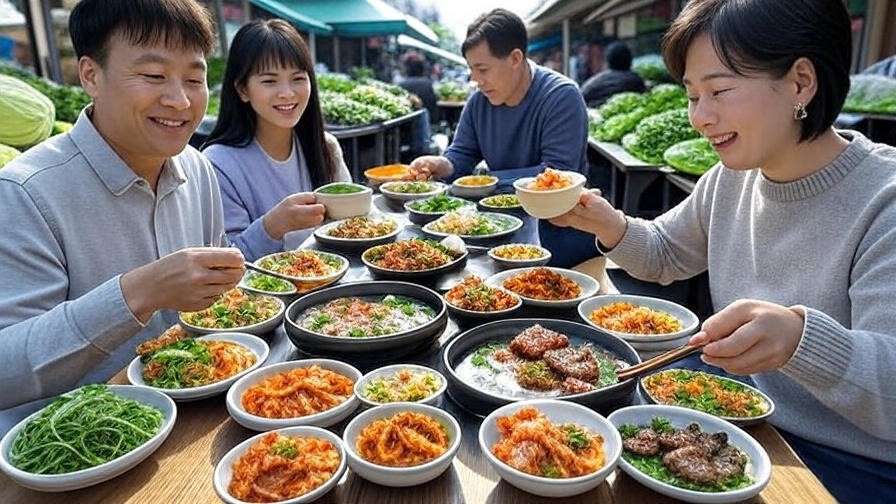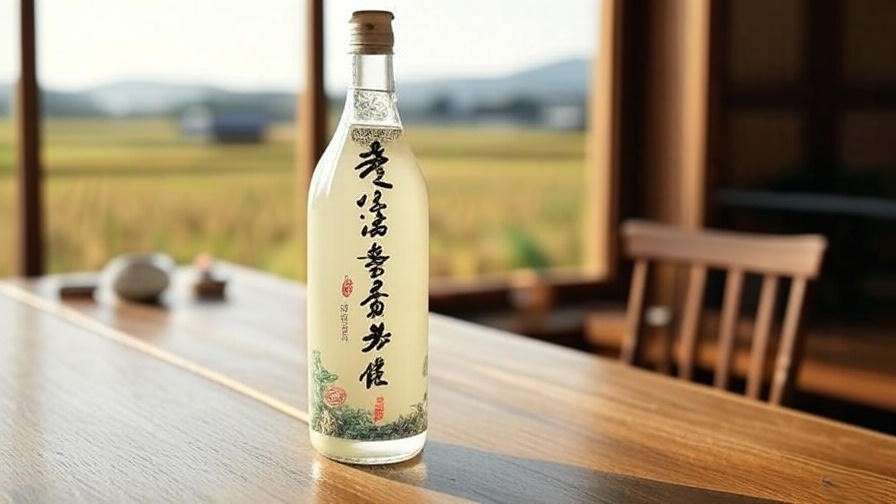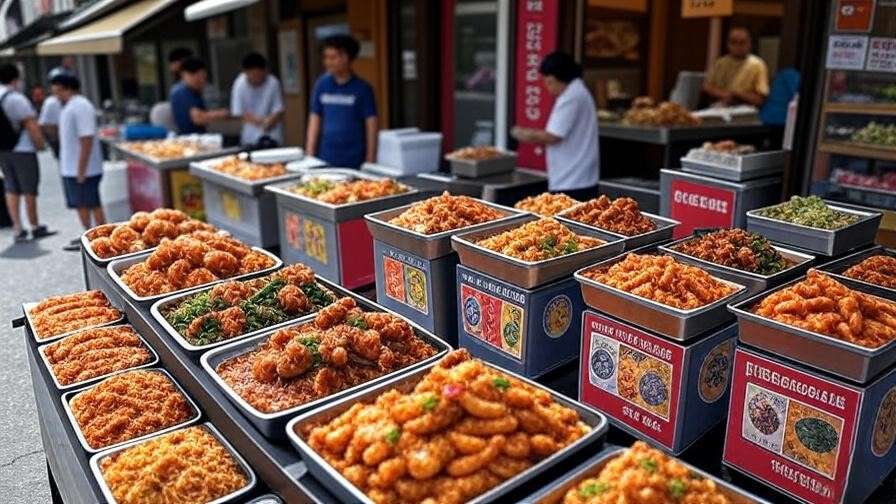Imagine stepping into Seoul’s bustling Gwangjang Market, where the air hums with the chatter of vendors and the vibrant colors of fresh vegetables in Korea catch your eye—crisp napa cabbage, aromatic perilla leaves, and snowy white radishes stacked high. For fans of Korean culture and drama, these vegetables are more than ingredients; they’re a gateway to the heart of Korea’s culinary soul. Inspired by iconic K-drama scenes of family meals and kimchi-making, this guide unveils the top 10 must-try vegetables in Korea, offering cultural insights, practical tips, and authentic recipes to elevate your culinary adventures.
Why Vegetables Are the Heart of Korean Cuisine
The Role of Vegetables in Korean Food Culture
Korean cuisine is a celebration of balance, rooted in the philosophy of yin-yang and the five elements—wood, fire, earth, metal, and water. Vegetables are central to this harmony, starring in banchan (side dishes) that accompany every meal. From the spicy tang of kimchi to the subtle crunch of seasoned sprouts, vegetables define Korean dining. K-dramas like Crash Landing on You showcase this vividly, with scenes of families gathering over tables laden with colorful banchan, reflecting Korea’s communal and seasonal approach to food. This tradition underscores the cultural significance of vegetables, making them essential for anyone exploring Korean culture.
Health Benefits of Korean Vegetables
Korean vegetables are not only flavorful but also packed with nutrients. For example, perilla leaves are rich in antioxidants, while Korean radish offers fiber and vitamin C. The emphasis on fresh, seasonal produce aligns with Korea’s wellness-focused cuisine, often highlighted in temple cuisine, which prioritizes plant-based dishes. Studies, such as those from the Korea Food Research Institute, show that fermented vegetables like kimchi support gut health due to their probiotic content. By incorporating these vegetables, you’re not just tasting Korea—you’re embracing a healthier lifestyle.
Expert Insight: Chef Hooni Kim, a renowned Korean-American chef, notes, “Vegetables in Korean cuisine are the unsung heroes. They bring balance, texture, and flavor, tying every meal together with tradition and care.”
Top 10 Must-Try Vegetables in Korea
1. Napa Cabbage (Baechu)
 Napa cabbage, or baechu, is the cornerstone of Korea’s most iconic dish: kimchi. Its crisp, juicy leaves soak up spicy seasonings, creating a tangy, fermented staple recognized by UNESCO as Intangible Cultural Heritage. Baechu appears in countless dishes, from kimchi jjigae (stew) to ssam (wraps), where it’s used to wrap grilled meats with ssamjang. Its versatility makes it a must-try for any Korean food lover.
Napa cabbage, or baechu, is the cornerstone of Korea’s most iconic dish: kimchi. Its crisp, juicy leaves soak up spicy seasonings, creating a tangy, fermented staple recognized by UNESCO as Intangible Cultural Heritage. Baechu appears in countless dishes, from kimchi jjigae (stew) to ssam (wraps), where it’s used to wrap grilled meats with ssamjang. Its versatility makes it a must-try for any Korean food lover.
Culinary Uses: Beyond kimchi, napa cabbage stars in soups like doenjang jjigae and fresh salads.
Tip: Choose heads with tightly packed, pale green leaves and no wilting for the freshest flavor.
Recipe Idea: Quick Baechu Kimchi
- Ingredients: 1 medium napa cabbage, ¼ cup gochugaru (Korean red pepper flakes), 2 tbsp fish sauce, 1 tbsp minced garlic, 1 tsp grated ginger, 2 tbsp salt, 1 tsp sugar, 2 chopped green onions.
- Instructions: Quarter cabbage, salt generously, and let sit for 2 hours. Rinse and drain. Mix gochugaru, fish sauce, garlic, ginger, and sugar into a paste. Coat cabbage thoroughly, add green onions, and pack into a jar. Ferment at room temperature for 1–2 days, then refrigerate.
2. Korean Radish (Mu)
Korean radish, or mu, is a sweet, crunchy staple with a milder flavor than daikon. Its snowy white flesh is a common sight in Korean households, featured in banchan and stews. Mu is essential in kkakdugi (cubed radish kimchi), a crunchy side dish that pairs perfectly with rich dishes like samgyeopsal (grilled pork belly). Its prominence in temple cuisine reflects Korea’s plant-based traditions.
Culinary Uses: Try mu namul (seasoned radish strips) or add it to beef bone soup (seolleongtang).
Recipe Idea: Mu Namul
- Ingredients: 1 small mu (peeled, julienned), 1 tsp sesame oil, 1 tsp soy sauce, 1 tsp sesame seeds, 1 minced garlic clove, 1 chopped green onion.
- Instructions: Blanch radish in boiling water for 1 minute, then drain. Toss with sesame oil, soy sauce, garlic, and green onion. Sprinkle with sesame seeds and serve chilled.
Tip: Look for firm, heavy radishes with smooth skin to ensure freshness.
3. Perilla Leaves (Kkaennip)
Perilla leaves, with their distinct minty and slightly nutty flavor, are a Korean favorite. Often used in ssam, these vibrant green leaves wrap rice, meat, and ssamjang for a fresh, flavorful bite. K-dramas like Itaewon Class highlight their role in casual dining scenes, where characters bond over shared wraps. Perilla leaves are also pickled or stir-fried for added depth.
Culinary Uses: Add to stews, pickle in soy sauce, or use as a garnish for bibimbap.
Tip: Store leaves wrapped in a damp paper towel in the fridge to maintain freshness for up to a week.
Recipe Idea: Kkaennip Jangajji (Pickled Perilla Leaves)
- Ingredients: 20 perilla leaves, ¼ cup soy sauce, 2 tbsp rice vinegar, 1 tbsp sugar, 1 tsp gochugaru, 1 tsp sesame oil.
- Instructions: Layer leaves in a container. Heat soy sauce, vinegar, sugar, and gochugaru until dissolved. Pour over leaves, add sesame oil, and let sit for 2 days before serving.
4. Green Onions (Pa)
 Long, slender green onions, or pa, are a backbone of Korean flavor. They add a fresh, mildly sharp taste to dishes like pajeon (green onion pancakes), a street food favorite often seen in K-dramas. Pa is also a key garnish for soups and stews, bringing color and crunch to every bite.
Long, slender green onions, or pa, are a backbone of Korean flavor. They add a fresh, mildly sharp taste to dishes like pajeon (green onion pancakes), a street food favorite often seen in K-dramas. Pa is also a key garnish for soups and stews, bringing color and crunch to every bite.
Culinary Uses: Use in pajeon, garnish for galbitang (short rib soup), or mix into kimchi.
Expert Insight: Seoul street food vendor Park Ji-hoon shares, “Choose green onions with bright, firm stalks and no slime for the best flavor in pajeon.”
Recipe Idea: Pajeon (Green Onion Pancakes)
- Ingredients: 1 cup flour, ¾ cup water, 1 egg, 5 green onions (cut into 5-inch pieces), 1 tsp salt, vegetable oil.
- Instructions: Mix flour, water, egg, and salt into a batter. Heat oil in a skillet, arrange green onions, and pour batter over. Cook until golden on both sides. Serve with soy dipping sauce.
5. Soybean Sprouts (Kongnamul)
 Soybean sprouts, or kongnamul, offer a nutty, crunchy texture that shines in dishes like kongnamul muchim (seasoned sprouts) and bibimbap. A staple in Korean home cooking, these sprouts are affordable, nutritious, and versatile, often featured in K-drama scenes of simple family meals.
Soybean sprouts, or kongnamul, offer a nutty, crunchy texture that shines in dishes like kongnamul muchim (seasoned sprouts) and bibimbap. A staple in Korean home cooking, these sprouts are affordable, nutritious, and versatile, often featured in K-drama scenes of simple family meals.
Culinary Uses: Season for banchan, add to soups like kongnamul guk, or mix into japchae.
Recipe Idea: Kongnamul Muchim
- Ingredients: 200g soybean sprouts, 1 tsp sesame oil, 1 tsp soy sauce, 1 tsp sesame seeds, 1 minced garlic clove, 1 chopped green onion.
- Instructions: Blanch sprouts for 2 minutes, then drain. Toss with sesame oil, soy sauce, garlic, and green onion. Top with sesame seeds and serve.
Tip: Avoid overcooking sprouts to preserve their crunch.
6. Spinach (Sigeumchi)
Korean spinach, or sigeumchi, is a tender green with a mild flavor, perfect for banchan and soups. Its prominence in temple cuisine highlights Korea’s plant-based traditions, emphasizing simplicity and mindfulness. Often featured in K-dramas during humble family meals, sigeumchi is a versatile vegetable that’s easy to prepare and packed with iron and vitamins.
Culinary Uses: Sigeumchi namul (seasoned spinach) is a classic banchan, while it also shines in japchae (stir-fried glass noodles) and soups like miyeok guk (seaweed soup).
Tip: Blanch spinach briefly (30 seconds) to retain its vibrant green color and tender texture.
Recipe Idea: Sigeumchi Namul
- Ingredients: 200g fresh spinach, 1 tsp sesame oil, 1 tsp soy sauce, 1 tsp sesame seeds, 1 minced garlic clove, pinch of salt.
- Instructions: Blanch spinach in boiling water for 30 seconds, then rinse in cold water and squeeze dry. Toss with sesame oil, soy sauce, garlic, and salt. Sprinkle with sesame seeds and serve chilled.
7. Zucchini (Hobak)
Korean zucchini, or hobak, is a mild, versatile vegetable that adds a delicate sweetness to dishes. Frequently seen in K-drama family dinners, hobak is a comforting ingredient in home-style cooking. Its soft texture makes it ideal for pan-frying or steaming, offering a subtle contrast to bolder flavors like gochujang.
Culinary Uses: Hobak jeon (zucchini pancakes) is a popular dish, while sliced hobak is often stir-fried or added to stews like doenjang jjigae.
Recipe Idea: Hobak Jeon
- Ingredients: 1 medium zucchini (sliced into ¼-inch rounds), ½ cup flour, 1 egg, ½ tsp salt, vegetable oil for frying.
- Instructions: Dip zucchini slices in flour, then beaten egg. Fry in hot oil until golden on both sides. Serve with a dipping sauce of soy sauce and sesame oil.
Tip: Choose small, firm zucchinis for the best texture and flavor.
8. Fernbrake (Gosari)
Fernbrake, or gosari, is a wild vegetable with an earthy, chewy texture, often harvested from Korea’s mountains. A staple in bibimbap and namul dishes, gosari reflects Korea’s connection to nature and foraging traditions. Its unique flavor makes it a must-try for adventurous eaters exploring authentic Korean cuisine.
Culinary Uses: Gosari namul (seasoned fernbrake) is a common banchan, and it’s also used in yukgaejang (spicy beef soup).
Tip: Dried gosari requires soaking overnight and boiling to soften before seasoning.
Recipe Idea: Gosari Namul
- Ingredients: 100g dried gosari, 1 tbsp soy sauce, 1 tsp sesame oil, 1 tsp minced garlic, 1 tsp sesame seeds.
- Instructions: Soak gosari overnight, then boil for 30 minutes until tender. Drain and season with soy sauce, sesame oil, and garlic. Top with sesame seeds and serve.
9. Lotus Root (Yeongeun)
Lotus root, or yeongeun, is a crunchy, mildly sweet vegetable with a stunning star-like pattern when sliced. Symbolizing purity in Korean culture, it’s often served during festive occasions like Chuseok. Its unique texture and aesthetic make it a favorite for both flavor and presentation.
Culinary Uses: Yeongeun jorim (braised lotus root) is a popular side dish, while fresh slices add crunch to salads.
Expert Insight: Food historian Dr. Lee Soo-jin explains, “Lotus root’s beauty and symbolism make it a cherished ingredient in Korean celebrations, connecting food to cultural values.”
Recipe Idea: Yeongeun Jorim
- Ingredients: 1 lotus root (peeled, sliced thinly), ¼ cup soy sauce, 2 tbsp rice syrup, 1 tbsp sesame oil, 1 tsp sesame seeds.
- Instructions: Boil lotus root for 5 minutes, then drain. Simmer in soy sauce, rice syrup, and water for 20 minutes until glossy. Finish with sesame oil and seeds.
10. Water Dropwort (Minari)
Water dropwort, or minari, is a peppery green with a celery-like crunch, gaining global fame through the film Minari and K-drama dining scenes. Its fresh, herbaceous flavor makes it a versatile addition to Korean meals, whether raw or cooked.
Culinary Uses: Minari jeon (pancakes), soups, or fresh in ssam wraps.
Recipe Idea: Minari Salad
- Ingredients: 100g minari, 1 tbsp gochujang, 1 tbsp rice vinegar, 1 tsp sesame oil, 1 tsp soy sauce, 1 tsp sesame seeds.
- Instructions: Rinse minari and cut into 2-inch pieces. Toss with gochujang, vinegar, sesame oil, and soy sauce. Sprinkle with sesame seeds and serve fresh.
Tip: Choose minari with bright green leaves and crisp stems for maximum freshness.
How to Source Authentic Korean Vegetables
Shopping in Korea
Exploring Korea’s vibrant markets like Gwangjang or Namdaemun is a sensory delight. Vendors display fresh napa cabbage, mu, and minari, often offering samples of banchan. Look for busy stalls, a sign of fresh stock, and ask vendors for tips on seasonal picks. Major grocery chains like E-Mart and Lotte Mart also stock high-quality vegetables, with clear labeling for organic options.
Finding Korean Vegetables Abroad
 Outside Korea, Asian grocery stores like H Mart or online retailers such as Weee! offer Korean vegetables like perilla leaves and mu. For hard-to-find items like gosari, dried versions are widely available. If mu is unavailable, daikon radish is a close substitute, though slightly less sweet.
Outside Korea, Asian grocery stores like H Mart or online retailers such as Weee! offer Korean vegetables like perilla leaves and mu. For hard-to-find items like gosari, dried versions are widely available. If mu is unavailable, daikon radish is a close substitute, though slightly less sweet.
Expert Tip: Partner with a local Korean market owner to learn about seasonal shipments and storage tips for authenticity.
Cooking Tips for Korean Vegetable Dishes
Essential Seasonings and Techniques
Korean vegetable dishes rely on a trio of seasonings: gochugaru (red pepper flakes), sesame oil, and soy sauce. Blanching preserves texture for greens like spinach and soybean sprouts, while pickling enhances napa cabbage and perilla leaves. Stir-frying with garlic and sesame seeds adds depth to dishes like gosari namul.
Pairing Vegetables with Korean Meals
A balanced Korean meal includes rice, soup, and multiple banchan. Pair mu namul and sigeumchi namul with a hearty soup like doenjang jjigae and grilled fish for a classic spread. For K-drama-inspired dinners, serve pajeon and minari salad with soju, mimicking casual dining scenes.
Recipe Example: Three-Dish Banchan Spread
- Dishes: Mu namul, sigeumchi namul, kkaennip jangajji.
- Instructions: Prepare each as per recipes above. Arrange in small dishes alongside rice and a protein like bulgogi. Serve with kimchi for authenticity.
Cultural Significance of Vegetables in Korean Dramas
 Vegetables in K-Drama Food Scenes
Vegetables in K-Drama Food Scenes
K-dramas like Itaewon Class and Reply 1988 showcase vegetables in heartwarming food scenes. In Crash Landing on You, characters bond over kimchi-making, highlighting napa cabbage’s role in community. These moments inspire global fans to recreate dishes like pajeon or bibimbap, deepening their connection to Korean culture.
Vegetables in Korean Festivals and Traditions
Vegetables shine during Chuseok, Korea’s harvest festival, where lotus root and fernbrake feature in festive dishes. Temple cuisine, seen in K-dramas about mindfulness, emphasizes vegetables like spinach and minari, reflecting sustainability and plant-based eating trends embraced globally.
FAQs About Korean Vegetables
- What’s the difference between Korean radish and daikon? Korean radish (mu) is shorter, rounder, and sweeter than daikon, with a denser texture ideal for kimchi.
- Can I make kimchi with non-traditional vegetables? Yes, try carrots or cucumber for unique twists, but napa cabbage remains traditional.
- Where can I buy authentic Korean vegetable seeds for home gardening? Online retailers like Kitazawa Seed Co. offer seeds for perilla, mu, and minari.
- Are Korean vegetable dishes vegan-friendly? Most are vegan, but check for fish sauce in kimchi or banchan recipes.
- How do I store Korean vegetables to maintain freshness? Wrap greens like perilla and minari in damp paper towels and refrigerate; store roots like mu and lotus root in cool, dry conditions.
From the fiery crunch of napa cabbage kimchi to the peppery freshness of minari, these top 10 vegetables in Korea offer a delicious gateway to the country’s culinary and cultural heritage. Whether you’re inspired by K-drama feasts or eager to explore authentic flavors, these ingredients bring Korea’s vibrant food scene to life. Visit a local Korean market, try a recipe like pajeon or mu namul, or watch a K-drama to spark your culinary creativity. Share your favorite Korean vegetable dishes in the comments or on social media to join the global K-food community!













